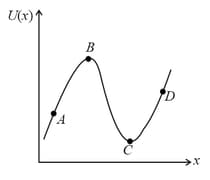HARD
Earn 100
A particle with an initial kinetic energy approaches the origin from in the presence of a conservative potential. Consider following expressions for the corresponding potential energy where is in meters:
(i)
(ii)
(iii)
(iv)
Here Select the correct statement(s):
(a)The particle will reverse its direction on reaching for the potential energy given by expression (ii)
(b)The particle will reach for the potential energy given by expression (iv)
(c)The particle will reach the origin for the potential energy given by expression (iii).
(d)The speed of the particle will decrease monotonically as the particle approaches the origin for the potential energy given by expression (i).
50% studentsanswered this correctly
Important Questions on Work, Energy and Power
MEDIUM
EASY
EASY
MEDIUM
MEDIUM
EASY
EASY

HARD
HARD
MEDIUM
The graphs below show the magnitude of the force on a particle as it moves along the positive -axis from the origin to . The force is parallel to the -axis and conservative. The maximum magnitude has the same value for all graphs. Rank the situations according to the change in the potential energy associated with the force, least (or most negative) to greatest (or most positive).

EASY
EASY
EASY
MEDIUM
| Column-I | Column-II | ||
| (a) | (i) | ||
| (b) | (ii) | ||
| (c) | (iii) | ||
| (d) | (iv) | ||
EASY
EASY
MEDIUM
EASY
MEDIUM
MEDIUM

